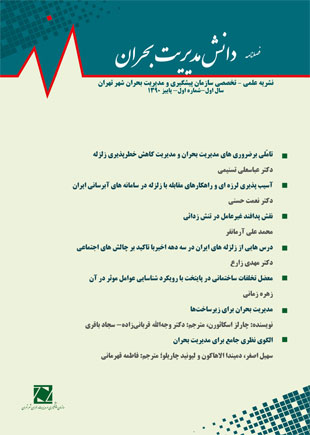فهرست مطالب

فصلنامه دانش پیشگیری و مدیریت بحران
پیاپی 1 (پاییز 1390)
- تاریخ انتشار: 1390/08/24
- تعداد عناوین: 8
-
صفحه 11
- مقاله های فارسی
-
صفحه 65
- ترجمه
-
صفحه 121
-
صفحه 143
-
Page 15So far, lots of considerable and useful measures have been taken to compile and formulate the infrastructures of risk reduction and disaster management. Disasters’ risk reduction optimal management requires a comprehensive compiled plan, so that it could include all state or private organizations, which have something to do with disaster management. Global experiences on dealing with accidents, as well as the achieved experiences in Iran indicate that firstly, risk management is not optimal in Iran and secondly, there is not a comprehensive plan for risk management in this field. The present article stresses that there is not an optimal applicable plan in Iran to consider all constituents related to risk reduction. To optimize what we have had so far, we should consider all elements impacting risk reduction management both in local and national level. In order to illustrate the most important subjects in risk management area, it is necessary to review important concepts, phrases and keywords in risk reduction and disaster management. In the present article, important concepts will be briefly described, and then some essential solutions will be presented for optimal disaster management.Keywords: Disaster optimal management, risk reduction, disaster management comprehensive plan
-
Page 39Lifelines, especially water supply equipment are not substantively designed ina way to be resistant against earthquake. The history of water supply equipment goes back to 50 years ago, while lifeline earthquake engineering is less than 30 years old. Even in advanced countries such as the USA and Japan, they have seriously dealt with formulating rulebooks and guidelines for seismic optimization in water supply equipment over the recent decade. The main constituents of the water supply equipment consist of tanks, transfer lines, treatment centers, and pump stations, basic and secondary transfer lines and tanks, which have different behaviors against earthquake. To assess the vulnerability and in order to improve the water supply equipment in Iran, various projects have been implemented in different cities, the most important of which conducted in Tehran in cooperation with Japanese experts. Wrapping up the conducted studies indicate that transfer lines are subject to damages and transfer networks with respect to their material and type of their joints are vulnerable against earth trembling. In the case of earthquake asbestos and concrete pipes are more vulnerable. Cast-iron pipes are so vulnerable against earthquake, too. Although ductile pipes are resistant in terms of body, their joints will be disassembled in earthquake. Poly Ethylene pipe is slightly damaged if their body is not metalized. In general, the buildings need to be resistant. The main concern is buried tanks. The main required measures to resist against earthquake in terms of hardware include arrangements made concerning pipe-fault intersections, using ductile pipes with anti tremble joints, supporting buildings, tanks, pump-stations and installing one-way valves in tanks. In terms of software it includes organizing the disaster and rehabilitation headquarters, various plans related to preparing personnel and people and also facilities, implementing managerial and operational maneuvers, public informing and emergency water supply. The present article while reviewing the existing status of water supply systems in Tehran, aims at introducing some solutions necessary to improve these supplies to prevent or reduce the supply systems’ damages.Keywords: Earthquake, damage, water supply, ABFA companies
-
Page 65Islamic Republic of Iran has been always threatened by USA and its strategic allies due to having ideological and geopolitical viewpoints, political and economic geography, its technological progress and also accessing to modern technologies such as uranium enrichment. USA and his allies have threatened Iran in different ways to influence all constituents of Iran’s national security in international level. For instance, USA has made efforts to create tension, and make Arab countries in the region fear of Iran and establish a coalition against Iran. Therefore, chief among the practical strategies that can establish deterrence and reduce vulnerability while eradicating tension, are passive defense, its expansion and development in all aspects, sectors and infrastructure of the country. The present article while reviewing the issue of passive defense looks into the proposed strategy for tension eradication.Keywords: Threat, passive defense
-
Page 81The findings of studies on affected areas, especially in stricken areas indicate that social problems in these areas are among the major challenges during aid and rehabilitation operation. Mostly, the social problems are so severe which may remain with a generation and of course cannot be reshuffled and mended. The present study while reviewing earthquake surveys conducted on Bam (2003), Manjil and Roodbar (1990) and Tabas (1979) aims at finding some solutions and organizing the social problems. Disorganization and disarray in many aspects of residents’ life can be noticed, at first glance. The routine life is disturbed and new relations are established. The present article aims at representing a realistic outlook for improving disaster management with respect to the above- mentioned viewpoint.Keywords: Iran earthquakes, disaster, social problems in disaster


